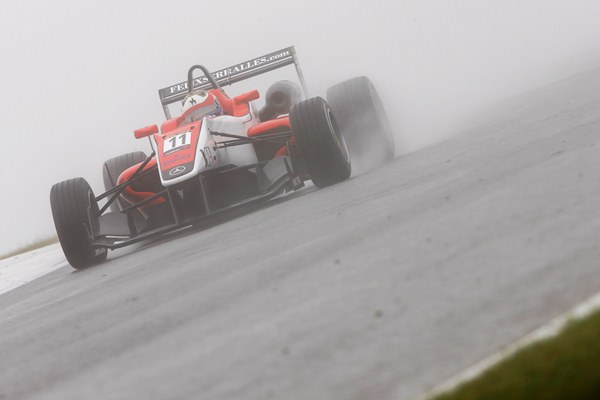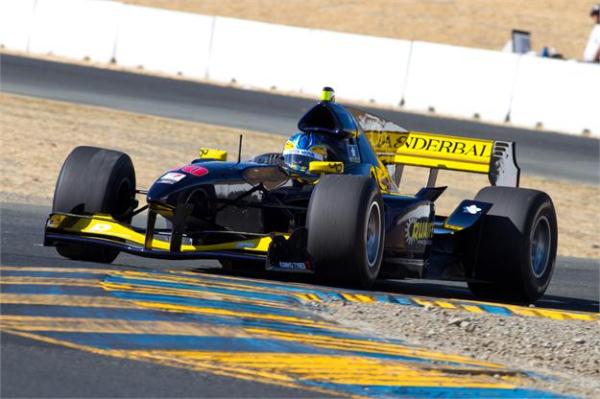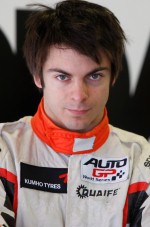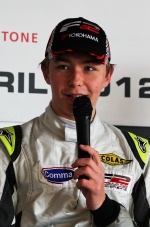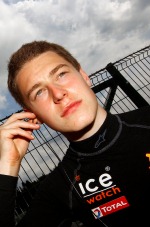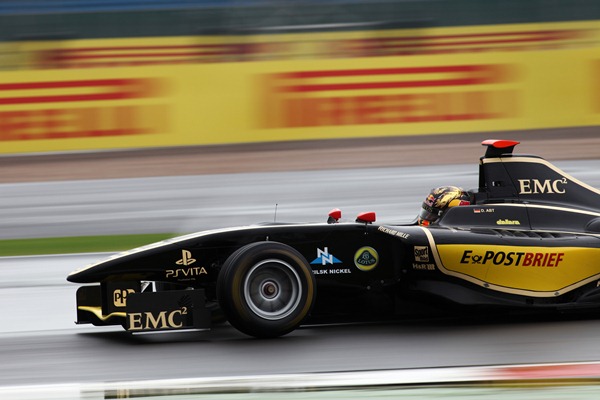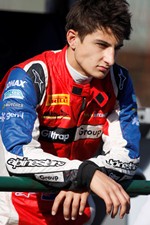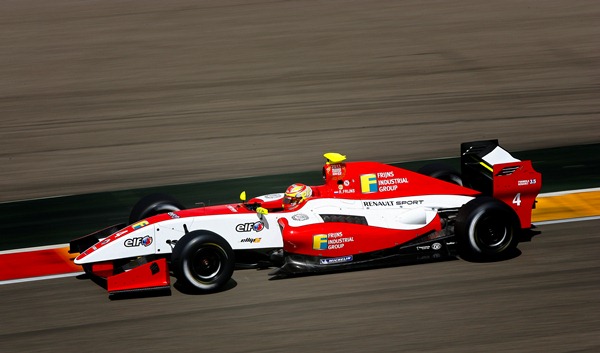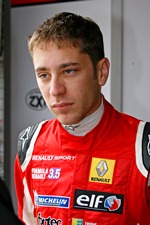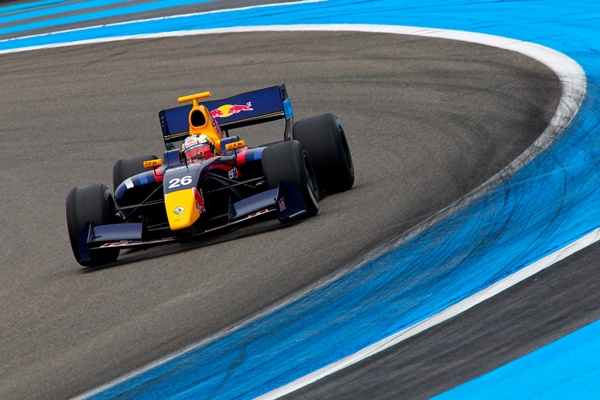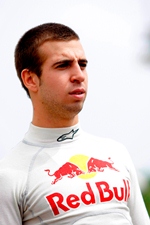Photo: Renault Sport / DPPI
Here it is – the fifth and final part of our end-of-year countdown, where we celebrate the most impressive young drivers of the season and crown our top talent of 2012…
10. Felix Serralles
Puerto Rico // age 20
Third in British F3 // Eighth in Toyota Racing Series
Despite a promising start to 2012 down under in the Toyota Racing Series, few had Serralles down on any list of the most promising drivers around. Arriving in British Formula 3 with Fortec, he was expected to play second-fiddle to fellow rookie Alex Lynn at best. Very quickly it was apparent that wouldn’t be the case, as Serralles got the better of title favourite Jack Harvey to take a race win during the season opener at Oulton Park.
A pole position, a win and a second place followed at Monza, and although Serralles went through a relative quiet spell over the next three weekends, he was back with a bang at the Norisring. On the streets of Nuremberg he claimed two second-places and a win in the British series, and two outright podiums against the best of Europe. With Harvey and Jaafar tripping over each other, he was right in title contention and moved into the lead with a win from pole at Spa-Francorchamps – again beating the top continental runners. Further strong performances followed back on British soil at Snetterton and Silverstone, but he didn’t quite have the outright pace to deny Harvey the title at Donington.
He may not have been as fast as Harvey or even Lynn, but Serralles put in an extremely mature campaign, in what can easily be forgotten was only his second in Europe. He never failed to finish, getting his car to the end in all conditions and it was that – combined with some great racing – that saw him in contention for the title until the end.
Having made his impression, Serralles will make the sensible move to the FIA’s new European Championship together with Fortec. It remains to be seen how competitive Fortec can be on a consistent basis, but the evidence suggests that Serralles will make the most of whatever he’s got. Before then, he’ll head back to New Zealand to challenge for the TRS crown.
Season highlight: If anyone thought his success in the British championship had been a fluke, Serralles mixed it with the best in Europe in both searing heat and torrential rain at the Norisring and marked himself out as one of the category’s top talents.
9. Jack Harvey
United Kingdom // age 19
British F3 champion
Harvey began his second year in British F3 as the pre-season favourite, but with experienced rivals and highly-rated rookies, it was going to be far from easy. After a slightly disappointing first year in the category, the pressure was on for Harvey to prove he deserved his backing from the Racing Steps Foundation – even if he’s said it wasn’t.
Things began well with a pole and two wins at Oulton Park, but after disappointing trips to Monza and Pau his weekend at Rockingham summed up his entire season quite well. After taking a double pole position (he claimed ten of the 20 available over the year), he could only finish fifth after a poor start. Starting from the front again in race three, he was in another league as he dominated the race. He was similarly untouchable at Brands Hatch, but another unsuccessful pair of events on the continent left him with it all to do again. On top at Snetterton, he was able to recover from series of penalties at Silverstone to wrap up the title in style with two wins at Donington.
That final weekend was proof – if needed – that at the top of his game and with the pressure on, Harvey was absolutely the class of the field. His qualifying record was superb, and he usually converted pole into victory and deservedly ended the year as champion. There’s still areas to work on – he never won from anywhere other than pole, and was strangely quiet away from the UK for someone who began his career in Europe – but his potential is huge.
The switch to GP3 might not seem like a big step, but with a new, faster car, the Pirelli tyres and the best team in the series in the shape of Lotus GP, he has an opportunity to hit GP2 in 2014 in even better shape than his RSF predecessor James Calado. After all, this is a young man who nearly beat Robin Frijns in Formula BMW in 2010.
Season highlight: Coming from behind his rivals to get the job done and the title secured at Donington, demonstrating his speed with a pair of wins from pole.
8. Adrian Quaife-Hobbs
United Kingdom // age 21
Auto GP champion
Unable to secure deals in GP2 or Formula Renault 3.5 after being left high and dry by Marussia, GP3 graduate Quaife-Hobbs had to settle for a late deal with Super Nova in Auto GP. It might have seemed less than ideal at the time, but the move worked out well for the Briton.
Quaife-Hobbs was easily the fastest driver in the field, following up pole position on his first weekend in such a powerful car at Monza with the top spot in five of the six remaining qualifying sessions. He claimed five race wins from the first five weekends, including a 30 second win at the Hungaroring and ending with a series-first double victory at Portimao. That saw him get one hand on the championship, wrapping it up at Curitiba despite a couple of pit dramas. He would probably have added another win from pole at Sonoma had he not been torpedoed by an out-of-control Antonio Pizzonia.
It might be easy to dismiss Quaife-Hobbs’ season as him simply having a lack of competition, but there were more experienced drivers in the field and he never gave them much of a chance, and nobody came close to showing such dominance in any international series. After his strong campaign in GP3 last year, 2012 saw him prove that was no fluke and that he is a driver who can compete and win at the highest level.
Eyeing a move to GP2 for 2013, Quaife-Hobbs enjoyed some very competitive tests with Addax and Arden late in the year. Without the budget the Spanish team will no doubt be after and with Arden keen to find space for its GP3 champion Mitch Evans, he’ll have to look elsewhere, but Jolyon Palmer’s transfer to Carlin has left a vacancy for a British star at iSport.
Season highlight: His pole position, two wins and two fastest laps at Portimao.
7. Matheo Tuscher
Switzerland // age 16
Second in FIA Formula Two Championship
Tuscher had registered on our radar last year as the winner of the Formula Pilota China title, but even after some promising testing performances in both Formula Two and GP3, nobody expected him to take pole position on his debut at Silverstone.
He had to make do with two top sixes from the races there, but next time out in Portimao he pushed Luciano Bacheta hard for the win in both races, having grabbed another pole for race two. He claimed more podium finishes over the next three weekends before making a breakthrough at his ‘home’ round at Paul Ricard, winning the opening race from pole and taking a second place in race two. By the season finale at Monza he was the only man who could stop Bacheta taking the title, and another win from pole in race one at the legendary Italian venue made it a close-run thing.
It’s easy to point to the lack of quality in the now-cancelled F2 series, but the cars were fast and all the other drivers that Tuscher was racing at the sharp end had several years of experience and were at least four years older than him. And not only was he fast with his four poles, but he made few errors with just two retirements – one of which came when he was cruelly rear-ended by Mihai Marinescu at the Hungaroring. A remarkable effort for someone who only turned 16 last week.
Tuscher tested in Formula Renault 3.5 post-season and is eyeing a move to the series, but he could be limited by budget despite deservedly acquiring new sponsors over the course of the season. A switch to the new, faster GP3 might be a better alternative.
Season highlight: His stunning pole position first time out at Silverstone.
6. Stoffel Vandoorne
Belgium // age 20
Eurocup Formula Renault 2.0 champion // Ninth in Formula Renault 2.0 NEC
With Daniil Kvyat staying on for another year, it seemed it would be a tough ask for Stoffel Vandoorne to take the honours in the Eurocup in 2012. But while the Russian racked up three wins from the first four races, Vandoorne gathered four top-four finishes to keep his rival in sight.
He then attacked at the Nurburgring with a double victory as Kvyat faltered, assuming the standings lead. Even though Kvyat twice beat him after starting from pole in Moscow, Vandoorne maintained his remarkable consistency to head into the final race at Barcelona with a 14 point lead having never finished outside the top four from the 13 races up to that point. An error on slicks on a damp track caused his first retirement and made it look like his hopes were over as Kvyat led the race, but the wet-shod Red Bull man fell backwards as the track dried and Vandoorne was champion. He would also have won the NEC title had he done something approaching the full season, having won five of the seven races he started.
Without as many wins as Kvyat, Vandoorne’s consistency might have been key to winning the Eurocup crown but he was fast too. He proved that in qualifying, taking six pole positions to Kvyat’s three. He might not have been as prepared to take risks in the races, but that may not be a bad thing. In what was a highly competitive field from which few drivers even managed to consistently score points, Vandoorne’s campaign was outstanding.
Vandoorne will use the Eurocup prize money to step up to FR3.5, and hopes to follow in the footsteps of 2011 Eurocup champion Frijns by taking the Dutchman’s place at the Fortec team. He broke the lap record at Motorland Aragon driving with the British team in post-season testing.
Season highlight: Two wins from pole at the Nurburgring Eurocup round, one week after he did exactly the same in the NEC.
5. Daniel Abt
Germany // age 20
Second in GP3 Series
After a disappointing time in the F3 Euro Series in 2011, Abt arrived in GP3 with high expectations after some impressive testing performances with top squad Lotus-ART. He didn’t show any title-contending form in the first half of the year, when he had to make do with a run of top sixes and a couple of podiums.
With all of his rivals at the sharp end having a previous season of experience in GP3, Abt improved as he got used to the car. His improved form began with pole position in Germany as the second half of the season began, but he was caught out there by changing weather conditions before fighting back for another second place in race two, a result he repeated in Hungary. Then at Spa he grabbed his maiden victory with the move of the season, diving down the inside of Antonio Felix da Costa and Mitch Evans as they fought with each other entering Les Combes. He had nothing more than an outside chance of the title heading to Monza, but made the most of it, storming to the win in race one and nearly stealing the crown by winning the second race. He also appeared in Formula Renault 3.5 at the end of the year and put in some competitive drives, even if he didn’t have any results to show for it.
It understandably took a few weekends for Abt to show his full potential in the GP3 car, but once he did he was as good as anybody else – even the on-form Felix da Costa. He finished first or second in five of the last seven races, and was the top scorer from the second half of the season. Most strikingly, he would have won the title by three points had he received full points for his win in the shortened race at Spa. He’d shown promise before, but this was the year that Abt stood out as one to watch on the big stage.
He’s made enough of an impression at ART to get a promotion to their GP2 team for 2013, and although he seemed to struggle for speed in post-season testing, he’s got the talent to make a good fist of it pretty quickly and the backers to stick around for a few years yet.
Season highlight: His Monza performances – giving it his all and only just falling short.
4. Mitch Evans
New Zealand // age 18
GP3 Series champion
Evans began the GP3 season as the overwhelming pre-season favourite after his promising rookie campaign of 2011, and finished up as champion. It was a lot closer than he would have liked, but Mark Webber’s protege was the most deserving driver and the quickest over the course of the season.
Starting with victory in Barcelona and adding a second on Spanish soil in Valencia, Evans was an early pacesetter together with Monaco victor Aaro Vainio. Evans gradually shook the Finn off and it seemed only a disaster would stop him from claiming the title. He went to Monza and edged out new nearest rival Antonio Felix da Costa to take his fourth pole position of the season and extend his points lead to 25.5 points. The title seemed only a formality, but after being forced to take to the inside of the first chicane in avoidance in both races – sustaining suspension damage the first time and a puncture the second – he failed to score in either race and held on by a margin of two points after Abt failed to win twice.
Some might say Evans was lucky to win the title that day, but it was in fact a series of misfortunes over the season that had him in that position in the first place. There were six races in which he failed to score, compared to three for Abt, with very little of that down to him – on three occasions he was thwarted by punctures. He didn’t do any of the jump starts or yellow flag infringements that affected his rivals. While Vainio tailed off towards the end and Abt and Felix da Costa only came on strong in the second half, Evans was right at the sharp end throughout the season, and topped qualifying at half the events.
Keen to step up to GP2 with Arden and having looked good in testing, Evans has had to try and scrape more funding together, but if there’s any justice he’ll make it and be competitive from the off.
Season highlight: Leading from start to finish in Valencia, leaving then-rival Vainio in his dust.
3. James Calado
United Kingdom // age 23
Fifth in GP2 Series
Fifth in GP2 doesn’t immediately sound like anything special, but that doesn’t really begin to tell the story of how good Calado was in 2012 – his rookie season in GP2 after graduating from GP3 as runner-up. He’d won the reverse grid race at the non-championship race in Abu Dhabi in late 2011, but it remained to be seen whether he could repeat that in 2012.
It didn’t take long for him to do so, beating highly-rated teammate Esteban Gutierrez to win the sprint race in Malaysia, then taking two top fives in the first Bahrain weekend. When the series returned to Europe and familiar tracks, Calado took advantage to claim pole in Barcelona, beaten to the win by veteran Giedo van der Garde but coming back to fourth in the sprint. On his first visit to Monaco he raced well to finish seventh after a poor qualifying, with a first corner tangle with Stephane Richelmi ending his victory chances in race two. Back on pole in Valencia, he was leading comfortably until a safety car caught him out, and was leading again in the sprint until a few corners from the end. A dominant second win came in the sprint race at Hockenheim, while at Spa he claimed a second and a third. At that stage he seemed set for third in the standings with even a slim chance of the title, but serious car troubles in Monza and a crippling illness in Singapore saw him slip to fifth by the end of the year.
Calado was one of the fastest drivers over the course of the year, and easily outscored champion Davide Valsecchi (in his fifth year of GP2) between Barcelona and Spa. With better fortune in Valencia and the final two rounds of the year, he would have given Valsecchi and Razia a run for their money in the standings, which is a sign of his relative ability given his lack of experience.
Unfortunately his performances did not attract the attention he deserved from the F1 teams, and he somehow remains yet to have driven an F1 car. Racing Steps Foundation were left with little choice other than to fund a second season of GP2 with Lotus next year, where the pressure will be on for him to win the title.
Season highlight: Dominating in Valencia until bad luck struck.
2. Robin Frijns
Netherlands // age 21
Formula Renault 3.5 champion
When Frijns arrived in Formula Renault 3.5 off the back of conseuctive titles in Formula BMW Europe and Eurocup Formula Renault, nobody gave him a hope of a third straight championship. Not in the new more powerful 3.5 machine, in a more-competitive-than-ever field full of highly-rated Formula 1 reserve drivers. Dominating pre-season testing was a sign, but few would have been putting money on him.
At the Aragon opener he proved that pace was real with a podium and then a win. Further podiums over the following events meant that after he claimed a second race win at Moscow, he was leading the championship at the mid-point. A second place at Silverstone maintained his advantage over Sam Bird, before a third win of the year at the Hungaroring, where he picked up his third and fourth pole positions of the campaign. A tough time in mixed conditions at Paul Ricard saw the points lead slip to Jules Bianchi, but in the first race at the Barcelona finale it was the more experienced Frenchman who cracked, finishing down in seventh after starting from pole as Frijns took third and the championship lead. That meant then when Frijns crashed into Bianchi in the final race, the title was the Dutchman’s.
For most, that incident tarnished considerably what had up to that point been an exemplary campaign. He’d shown his aggression – forcing Kevin Magnussen into the barrier at the start in Monaco for example – but he hadn’t overstepped any lines and given his inexperience, he’d barely put a foot wrong. His attitude on and off the track isn’t to everyone’s liking – mine included – but there can be no questioning his speed and driving ability.
Frijns has landed a well-deserved reserve driver role at Sauber, a team with a great reputation for nurturing young talent, but driving opportunities seem to be limited for him next year and with little financial backing, he might have to wait a while for a vacancy to arise. He’s almost won the FR3.5 title too soon – some in F1 may still see him as too rough around the edges.
Season highlight: Victory first time out at Aragon.
1. Antonio Felix da Costa
Portugal // age 21
Fourth in Formula Renault 3.5 Series // Third in GP3 Series // Macau Grand Prix winner
The story of Felix da Costa’s 2012 is a remarkable one. At the start of the year he was eyeing a step up to GP2, but as it was he could only scrape the budget together to do a second full season in GP3, this time with Carlin. 2011 had been a disappointment, but on paper he had the experience and the talent to rival pre-season favourite Mitch Evans.
Pole for the Barcelona opener seemed like a good start, only for him to jump the start. After a third round of the season at Valencia plagued by brake problems, he had just 27 points to his name compared to Evans’ 78. But that weekend he had Red Bull logos on his helmet, having been signed to the Junior Team after a recommendation from Trevor Carlin. He enjoyed a decent FR3.5 debut at the Nurburgring with the previously-struggling Arden Caterham team, while he won at Silverstone in his first race back in GP3, but a double retirement in Germany led to him ruling out his title chances. But then in Hungary he became the first double winner in GP3’s history, following that up with two second-places at Spa and only having his title hopes end when he got stuck in gear at Monza. In FR3.5 he improved with each weekend, claiming a maiden win in Hungary, then a win and a second at Paul Ricard before a stunning double victory at the Barcelona finale. Not content with that, he went and won the Macau Grand Prix – his first major race in an F3 car for 12 months and his first in the latest chassis.
By the end of the year, Felix da Costa was winning in any car he sat in. With a bit more luck, his GP3 form would have been enough to claim the title, while after just a handful of weekends in FR3.5 he was in a class of his own at the head of a highly-competitive series, winning four of the last five races. Finishing just 23 points shy of Frijns, one more weekend might have been enough for him to be champion. And if anyone thought that performance could just be down to him feeling particularly at home in FR3.5, his Macau victory proved once and for all that he was at the top of his game. Some now think he’s the next Vettel, but his 2011 struggles should not be forgotten, and his one-lap speed is still not a match for his race pace, but the potential is certainly there.
A full year in FR3.5 in 2013 will allow him to prove his recent form is more than just form, and if he maintains his dominance then don’t bet against a mid-season promotion into F1 once he’s had some Friday running.
Season highlight: There were plenty, but his dominance of the FR3.5 finale at Barcelona was perhaps the most remarkable.
Click to view the earlier parts of the top 50: part one, part two, part three and part four.
PaddockScout wishes all our readers a Merry Christmas and a Happy New Year. Thanks for your support in 2012 and we’re looking forward to doing it all over again in 2013.
